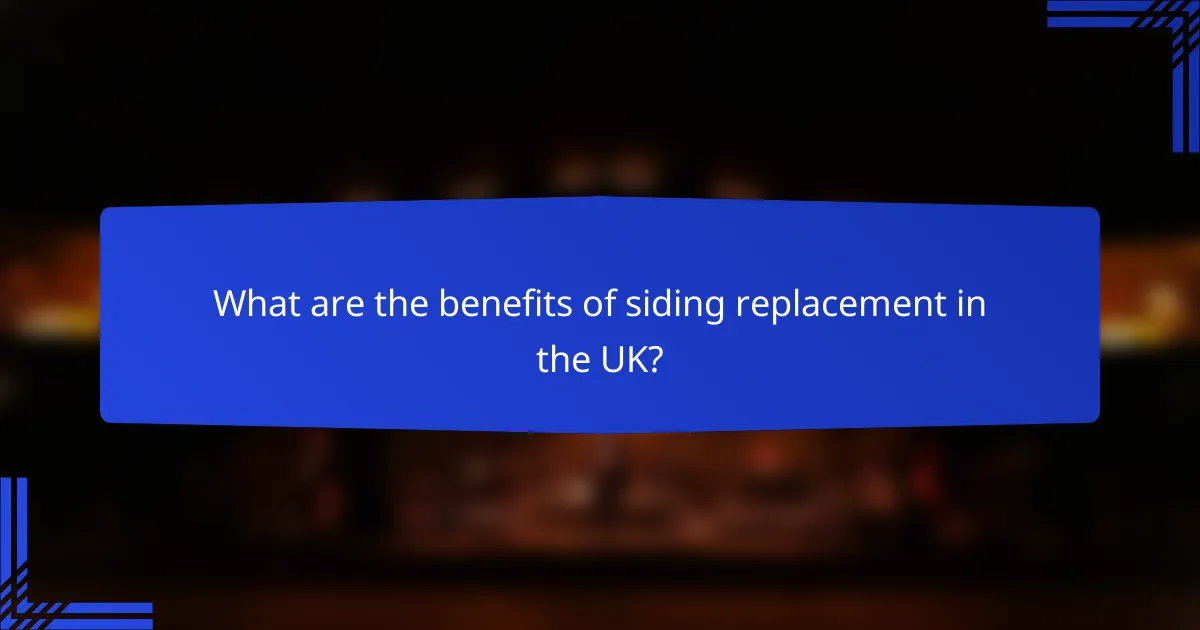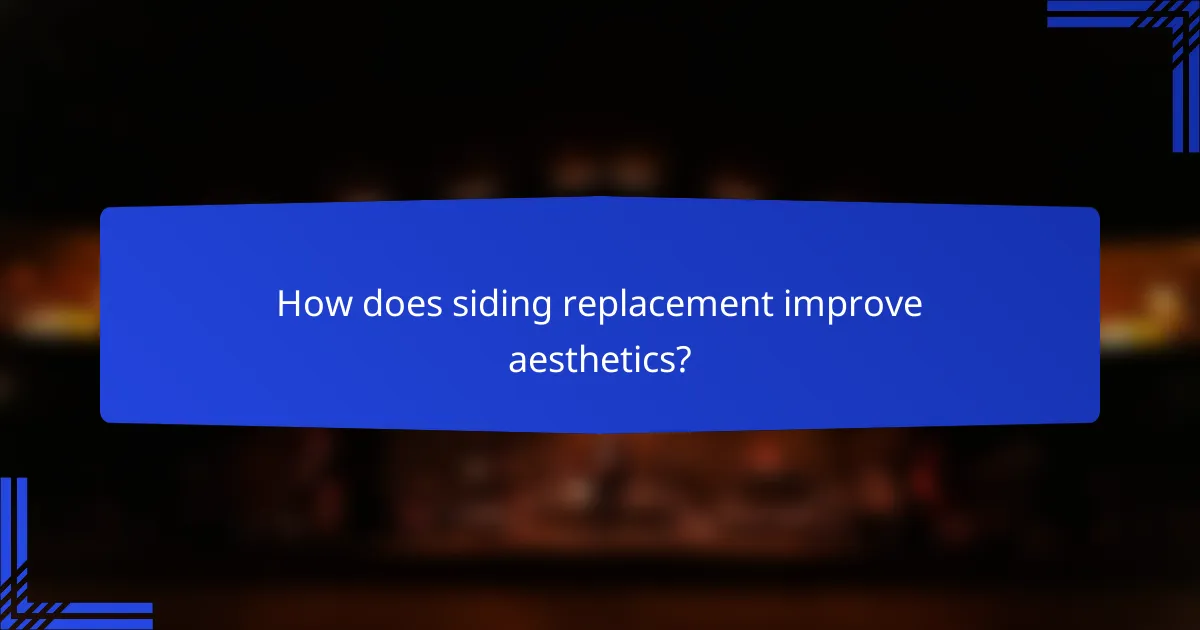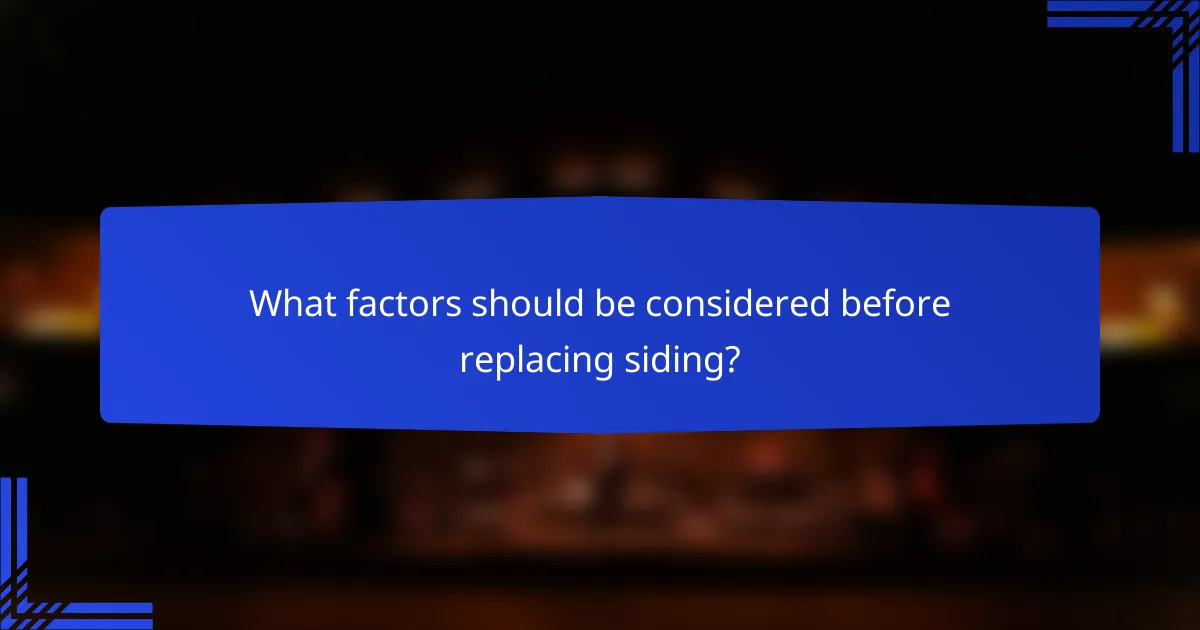Siding replacement is a valuable investment for homeowners seeking improved protection, aesthetic enhancement, and low maintenance. By upgrading to modern materials, you can bolster your home’s defense against the elements while achieving a fresh, contemporary look that increases property value. Additionally, low maintenance options like vinyl and composite siding ensure durability without the hassle of frequent upkeep.

What are the benefits of siding replacement in the UK?
Siding replacement in the UK offers enhanced protection, aesthetic improvement, and low maintenance for homes. Upgrading your siding can significantly boost your property’s resilience against the elements while also elevating its visual appeal.
Enhanced protection against weather
New siding provides a robust barrier against rain, wind, and temperature fluctuations, which are common in the UK. Materials like fiber cement or vinyl can withstand harsh weather conditions, reducing the risk of water damage and mold growth.
When choosing siding, consider options that meet UK building regulations for weather resistance. Ensure proper installation to maximize protection, as poorly installed siding can lead to leaks and structural issues.
Improved energy efficiency
Replacing siding can enhance your home’s energy efficiency by providing better insulation. Insulated siding helps maintain a consistent indoor temperature, potentially reducing heating and cooling costs by a noticeable margin.
Look for siding materials with high R-values, which indicate better thermal resistance. This improvement can lead to savings on energy bills, making it a practical investment for homeowners in the long run.
Increased property value
Upgrading your siding can significantly increase your property’s market value. A well-maintained exterior not only attracts potential buyers but also enhances curb appeal, making your home more desirable in the competitive UK real estate market.
Consider the return on investment (ROI) for different siding materials. While some options may have higher upfront costs, they can yield better long-term value through increased property worth and lower maintenance needs.

How does siding replacement improve aesthetics?
Siding replacement significantly enhances the visual appeal of a home, offering fresh designs and modern materials that can transform its exterior. By updating siding, homeowners can achieve a more contemporary look while also increasing property value.
Variety of materials and styles
Homeowners have access to a wide range of siding materials, including vinyl, wood, fiber cement, and metal. Each material offers distinct advantages in terms of durability, maintenance, and appearance, allowing for tailored choices based on personal preferences and local climate conditions.
For instance, vinyl siding is popular for its affordability and low maintenance, while wood siding provides a classic aesthetic but requires more upkeep. Exploring various styles, such as lap, board-and-batten, or shingle, can further enhance the home’s character.
Customizable colour options
Modern siding options come with an extensive palette of colors, enabling homeowners to select shades that complement their architectural style and neighborhood. Choosing the right color can significantly impact curb appeal, making the home more inviting and visually striking.
When selecting colors, consider the surrounding environment and the home’s architectural features. Neutral tones often blend well with various styles, while bold colors can make a statement. It’s advisable to view samples in different lighting conditions to ensure satisfaction with the final choice.

What are the low maintenance options for siding?
Low maintenance siding options include materials that require minimal upkeep while providing durability and aesthetic appeal. Vinyl and composite siding are popular choices due to their resistance to weathering, fading, and pests, making them ideal for homeowners seeking convenience.
Vinyl siding durability
Vinyl siding is known for its impressive durability, often lasting 20 to 40 years with proper installation. It resists moisture, rot, and pests, making it a practical choice for various climates. Additionally, vinyl does not require painting, as it comes in a wide range of colors that resist fading.
When considering vinyl siding, look for options with a thickness of at least 0.040 inches for better resistance to impact and harsh weather. Regular cleaning with soap and water can maintain its appearance, but it typically requires less frequent maintenance compared to wood or other materials.
Composite siding features
Composite siding combines materials like wood fibers and resins, offering a balance of durability and aesthetic appeal. It mimics the look of natural wood while providing resistance to rot, insects, and warping. This option can last 30 years or more with proper care.
One key feature of composite siding is its ability to be painted, allowing homeowners to change colors over time without replacing the material. However, it may require occasional cleaning and repainting, making it slightly more maintenance-intensive than vinyl. Consider composite siding if you desire a wood-like appearance without the high upkeep.

What factors should be considered before replacing siding?
Before replacing siding, it’s essential to evaluate your budget, local climate, and the desired aesthetic outcome. Each of these factors plays a crucial role in ensuring that the new siding meets your needs for protection, maintenance, and appearance.
Budget and cost estimates
Your budget will significantly influence the choice of siding materials and installation methods. Costs can vary widely, with basic vinyl siding starting at around $2 to $7 per square foot, while premium options like fiber cement or wood can range from $5 to $15 or more per square foot.
When estimating costs, consider not only the material but also labor, which can add another $1 to $3 per square foot. It’s wise to obtain multiple quotes from contractors to ensure competitive pricing and to account for any additional expenses such as permits or disposal fees.
Local climate considerations
The local climate is a critical factor in selecting siding materials that will withstand environmental conditions. For instance, areas with high humidity may benefit from materials resistant to mold and rot, such as fiber cement or vinyl, while regions prone to extreme temperatures might require insulation properties.
Additionally, consider local building codes and regulations that may dictate specific siding materials or installation methods. Understanding these requirements can help avoid costly mistakes and ensure compliance with local standards.

How do I choose the right siding material?
Choosing the right siding material involves considering factors such as durability, maintenance, aesthetics, and cost. Each material offers unique benefits and drawbacks, so evaluating your specific needs and local climate is essential.
Comparing wood, vinyl, and fibre cement
Wood siding is known for its natural beauty and insulation properties but requires regular maintenance to prevent rot and insect damage. Vinyl siding is low-maintenance, resistant to fading, and available in various styles, making it a popular choice for homeowners. Fibre cement combines the best of both worlds, offering durability and a wood-like appearance while being resistant to pests and fire.
When comparing costs, vinyl is generally the most affordable option upfront, while wood may have higher initial costs due to installation and maintenance. Fibre cement typically falls in the mid-range but can provide long-term savings due to its durability.
Long-term maintenance requirements
Wood siding requires regular painting or staining every few years to maintain its appearance and protect against the elements. In contrast, vinyl siding is virtually maintenance-free, needing only occasional cleaning with soap and water to keep it looking fresh.
Fibre cement siding requires minimal upkeep, usually needing repainting every 10 to 15 years, depending on the quality of the paint used. It’s essential to inspect all siding types regularly for damage and perform timely repairs to extend their lifespan.

What are the installation steps for siding replacement?
Siding replacement involves a systematic process to ensure proper installation and lasting protection. Key steps include preparing the area, removing old siding, and installing new materials while adhering to local building codes.
Preparation and removal of old siding
Begin by preparing the work area, which includes clearing any obstacles and ensuring safety measures are in place. Remove any fixtures, such as lights and shutters, that may interfere with the siding replacement.
Next, carefully remove the old siding using appropriate tools like a pry bar or a siding removal tool. Take care to avoid damaging the underlying structure, and inspect for any signs of rot or damage that may need addressing before new siding is installed.
Installation of new siding
Once the old siding is removed, install a moisture barrier to protect against water infiltration. This step is crucial for maintaining the integrity of the home and can help prevent mold and rot.
When installing the new siding, follow the manufacturer’s instructions closely. Ensure that each panel is secured properly and overlaps correctly to provide optimal protection. Consider using materials that require minimal maintenance, such as vinyl or fiber cement, to enhance durability and aesthetics.

What are the costs associated with siding replacement?
The costs for siding replacement can vary significantly based on materials, labor, and the size of the home. Homeowners typically spend anywhere from a few thousand to over ten thousand dollars, depending on these factors.
Material Costs
Material costs are a major component of siding replacement expenses. Common siding materials include vinyl, wood, fiber cement, and metal, each with different price ranges. For instance, vinyl siding may cost between $2 to $7 per square foot, while fiber cement can range from $5 to $10 per square foot.
When selecting materials, consider durability, insulation properties, and maintenance requirements. Higher-quality materials may have a higher upfront cost but can provide better long-term value through reduced maintenance and energy savings.
Labor Costs
Labor costs for siding installation can also vary widely, typically ranging from $1 to $3 per square foot. Factors influencing labor costs include the complexity of the installation, local labor rates, and the condition of the existing siding.
Hiring experienced contractors may increase initial costs but can lead to better workmanship and fewer issues down the line. Always obtain multiple quotes to ensure competitive pricing and check references for quality assurance.
Additional Costs
In addition to materials and labor, homeowners should budget for additional costs such as permits, disposal fees for old siding, and potential repairs to underlying structures. These costs can add several hundred to a few thousand dollars to the total project price.
It’s wise to set aside a contingency fund of around 10-20% of the total budget to cover unexpected expenses during the siding replacement process. This ensures you are prepared for any surprises that may arise.
